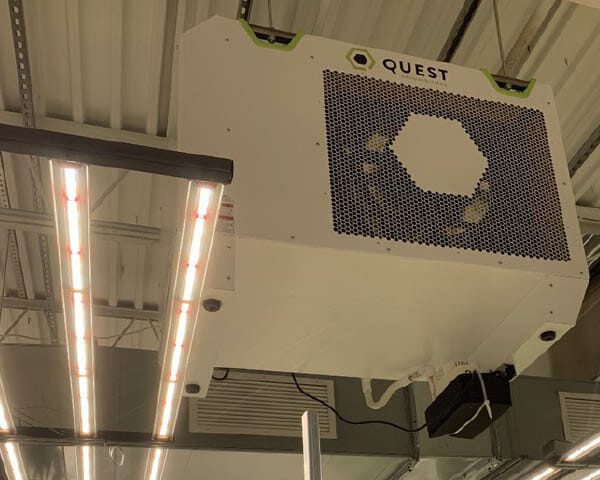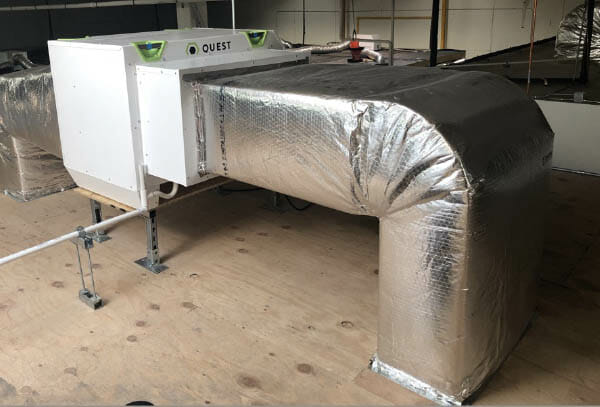FAQ:
California title 24 updates
Quest has compiled a list of California Title 24 FAQ. These frequently asked questions regarding to the latest updates to Title 24, Part 6, which went into effect January 1, 2023. These updates include Controlled Environmental Horticulture (CEH) facilities.
Title 24, Part 6, is the portion of the California Code of Regulations focusing on state energy efficiency requirements for residential and nonresidential buildings. Also known as “The Energy Code,” updates are made every three years. The 2022 Energy Code being the latest version.
Code additions include specific rules regarding Controlled Environment Horticulture (CEH) have been added to govern agricultural facilities. In section 120.6 (h), CEHs include Greenhouses, Conditioned Greenhouse and Indoor Growing. These new regulations include requirements for dehumidification efficiency. In addition, lighting, heating, cooling efficiency are addressed.
Prior to the adoption of 2022 Energy Code, no efficiency standard existed for dehumidifiers built for commercial, industrial or agricultural applications. While several parties worked to develop a set of rules for dehumidifiers, the State of California decided to adopt the regulations found in 10 CFR 430.32(v)2 to be certain they do not pre-empt federal regulation.
The Standard reads:
(h) Mandatory requirements for Controlled Environment (CEH) spaces.
A. Dehumidifiers subject to regulation under federal appliance standards tested in accordance with 10 CFR 430.23(z) and Appendix X or X1 to Subpart B of 10 CFR Part 430 as applicable, and complying with 10 CFR 430.32(v)2;
B. Integrated HVAC system with on-site heat recovery designed to fulfill at least 75 percent of the annual energy for dehumidification reheat;
C. Chilled water system with on-site heat recovery designed to fulfill at least 75 percent of the annual energy for dehumidification reheat; or
D. Solid or liquid desiccant dehumidification system for system designs that require dewpoint of 50 F or less.
This means that standalone dehumidifiers must meet the minimum requirements of the DoE energy efficiency regulation set out for consumer product (residential) dehumidifiers.
According to California Title 24, the definition of a portable dehumidifier in a cultivation is any non-ducted dehumidifier.
Example: A dehumidifier that is hanging in a space, but not ducted? Consider it portable!
Under California Title 24, the definition of a whole home dehumidifier is any dehumidifier which has ducting attached to it.
Or, “Does the requirement to comply with Appendix X1 to Subpart B of 10 CFR Part 430 include compliance with the two definitions of dehumidifier classification and their separate rating conditions?”
The 2022 Energy Code explains dehumidifiers must comply with every part of 10 CFR 430, except the requirement to be certified. This includes the definitions of “portable” (installed without ductwork) and “whole-home” (installed with ductwork).
A dehumidifier does not need to be registered in the Title 20 Modernized Appliance Efficiency Database System (MAEDbS) to qualify under Title 24. Industrial units can be voluntarily added as a way to demonstrate compliance.
If the units you are installing do not meet Title 24 energy efficiency requirements, gaining final approval of your project from the Authority Having Jurisdiction (AHJ) may be more complicated.
Enforcement of Title 24 falls under the local or county building department with jurisdiction over your property. Architects, engineers and energy consultant designing facilities should be very familiar with the process. Generally, Title 24 compliance documentation needs to be submitted to the building department prior to the issuance of building permits on a new facility or an addition to an existing facility.
The unit does not need to be certified by DOE, but it must meet all requirements of the certification process for dehumidifiers found in 10 CFR 429.12 (certification) and 10 CFR 430.32 (energy conservation).
To be certified, a dehumidifier must follow a strict testing protocol to determine its Energy Factor rating (i.e. energy efficiency level). Accordingly, these values must then be submitted to the DOE for verification and inclusion in the E.E.R.E.’s Compliance Certification Database.
Units that comply with Title 24 must follow all the rules of 10 CFR 429.12 and 10 CFR 430.32 to determine the Energy Factor of the unit in a Portable (un-ducted) and Whole-home (ducted). Most importantly, this information must be made available upon request but does not need to be submitted to the DOE for verification or inclusion in their database.
Under Title 24, replacement units need to meet the energy efficiency requirements if a building permit is required. Basically, if a building permit is not required, such as simply replacing a unit that is not working properly, you can use any Quest model we have available. Notably, replacing equipment may be an opportunity to increase the energy efficiency of your facility. The potential savings can be surprising!
have additional questions?
Our team is available to discuss your questions further or help you find the correct solution for your cultivation.



